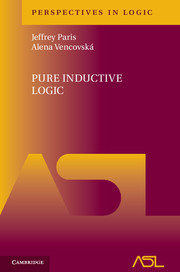PREFACE
Published online by Cambridge University Press: 05 May 2015
Summary
We have been motivated to write this monograph by a wish to provide an introduction to an emerging area of Uncertain Reasoning, Pure Inductive Logic. Starting with John Maynard Keynes's ‘Treatise on Probability’ in 1921 there have been many books on, or touching on, Inductive Logic as we now understand it, but to our knowledge this one is the first to treat and develop that area as a discipline within Mathematical Logic, as opposed to within Philosophy. It is timely to do so now because of the subject's recent rapid development and because, by collecting together in one volume what we perceive to be the main results to date in the area, we would hope to encourage the subject's continued growth and good health.
This is primarily a text aimed at mathematical logicians, or philosophical logicians with a good grasp of Mathematics. However the subject itself gains its direction and motivation from considerations of rational reasoning which very much lie within the province of Philosophy, and it should also be relevant to Artificial Intelligence. For this reason we would hope that even at a somewhat more superficial and circumspect reading it will have something worthwhile to say to that wider community, and certainly the link must be maintained if the subject is not to degenerate into simply doing more mathematics just for the sake of it. Having said that however we will not be lingering particularly on the more philosophical aspects and considerations nor will we speculate about possible application within AI. Rather we will mostly be proving theorems and leaving the reader to interpret them in her or his lights.
This monograph is divided into three parts. In the first we have tried to give a rather gentle introduction and this should be reasonably accessible to quite a wide audience. In the second part, which deals with ‘classical’ Unary Pure Inductive Logic, the mathematics required is a little more demanding, with more being left for the reader to fill in, and this trend continues in the final, ‘post classical’, part on Polyadic Pure Inductive Logic.
- Type
- Chapter
- Information
- Pure Inductive Logic , pp. ix - xPublisher: Cambridge University PressPrint publication year: 2015

